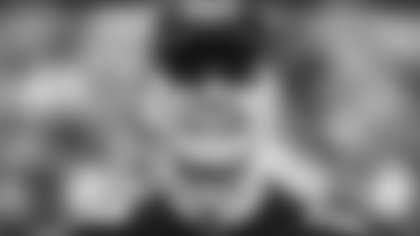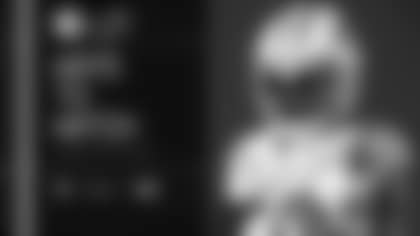
Gary Hammond could have set a record for NIL if it had been around when he was a three-year letterman at SMU from 1969-71.
A wide receiver as a sophomore, a running back as a junior, and a quarterback as a senior, Hammond was an All-Southwestern Conference selection each year, and the conference's Player of the Year his final season.
He played in two college all-star games including the East-West Shrine Game, where he was coached by a familiar face, SMU's Hayden Fry, who put his star player's versatility on display by having him see action at all three positions.
Hammond's coach at the Hula Bowl, San Diego State's Don Coryell, did the same.
"That's where I basically started hearing from some of the people because all the professional teams had somebody at those games. I guess that's when I was noticed," Hammond said.
One of the teams that took notice were the Jets, who chose Hammond in the third round of the 1972 NFL Draft.
"I wasn't listening to the draft, and got a call from (Jets Head Coach) Weeb Ewbank, and he said, 'I just want to let you know that you're going to be a New York Jet and we're going to want you up here in two weeks,'" Hammond said. "Everybody that they drafted that year went in two weeks after the draft, and got to meet everybody."
When Hammond reported for training camp later that summer, he was able to meet everybody on the team but Joe Namath, who was holding out for a more lucrative contract. Because of the veteran's absence, the rookie saw unexpected extra time at quarterback to go along with taking reps as a wide receiver.
"When I talked to Weeb about my history of what all I've done, he said, 'Well, we're going to use a little bit of all that.' And so I went there and played a little bit of everything," Hammond said. "I can remember when Weeb came up to me and says, 'Hey, I want you to stay after practice to hold for the kicker.' So I was practicing that, as well.
"You know, I think had I played three years of quarterback at SMU, when I came to the Jets, I would have been much more prepared to be a professional quarterback than I really was. I didn't get to play a whole lot of quarterback in the college days.
"And so, yeah, I was drafted to be a quarterback, but I think I was also drafted to return punts and kickoffs and play running back and wideout. And wideout was probably what they would want me to play with Joe being the quarterback."
And when the veteran quarterback ended his holdout and he and Hammond met…
"I think he had knee surgery the year before that, and so he was a little bit different-type quarterback. He was a strictly drop-back quarterback," Hammond said. "Wasn't a whole lot of scrambling that Joe was doing back in those years. But still a fantastic, great football player. I treasure the fact that I was just on his team for a while."
It was only "for a while" because Hammond suffered a knee injury during the preseason. A loose cartilage that required surgery forced him to witness his rookie season while rehabbing.
Healthy and back the following campaign, a miscalculation by Ewbank before the final preseason game meant Hammond wouldn't have a chance to being any closer to playing in a regular-season game for the Jets than he did the year before.
"Weeb called me into his office," Hammond said, "and I don't know if he was, but he sure seemed like he was very disappointed. He said, 'Gary, we did something that we thought we could sneak by, but it didn't work. We basically put you on waivers and when you put somebody on waivers, all the other teams have the opportunity to pick you up. We were hoping you would be able to go through and we'd keep you here. But the Cardinals, Don Coryell, he saw you being available and picked you up. And so that means you've got to be in St. Louis tomorrow. We took a chance and lost.'
"I was disappointed. I'd never been said no to in my life in football. I mean, in high school, I was All-State and all that kind of stuff. In college, I was All-(Southwestern) Conference a few times. So I never had anybody say, 'I don't want you.' And so when I heard I was leaving the Jets, in my little pea-brain, I was saying, 'Oh, man, they don't want me anymore.'
"But when he said the St. Louis Cardinals and mentioned Don Coryell, I'm going (to myself) that's the reason! You're going there because he knows you. He's watched you play and wants you on his team."
Spending four seasons with the Cardinals, Hammond retired from the game in 1977. "When I look back at the history of my career in NFL, I ran into some really fantastic human beings, from players to coaches,' he said. "And obviously that first coach was the example of how it ought to be done."
Hammond is also an example of how it ought to be done by taking steps to establish a second career while still partaking in the first.
"When you were playing in the NFL, you still had to work. I mean, I was making $18,000 my first year. And so I became a banker," Hammond said. "I was worked for North Dallas Bank. Darrell LaFitte, who was basically the Chairman of the Board of the bank, was from my hometown. He also was an SMU football player graduate, and he hired me. So the whole time I played professional football, I was a banker. And it was fantastic.
"And when I retired, I became a (fulltime) banker but it didn't last long. I only did it for two more years and then I went into the real estate business with the mayor the city of Dallas, Bob Folsom. And I'm still at the same spot, with Sabre Realty. I was building office buildings and leasing office buildings and am so still here running the office building sector."
Making their home in the Dallas suburb of Plano, Hammond and his wife, Beverly, have three daughters: Nicole, Stacey, and Jennifer; and 10 grandchildren.
"Beverly, oh, my goodness, I caught the prize when I came to SMU," Hammond said. "We met the first month we were on campus. We started dating and got serious. We got married just a couple of weeks after graduation, and I have been blessed big time with her. I have lived the Walter Mitty tale and it's been fantastic."













